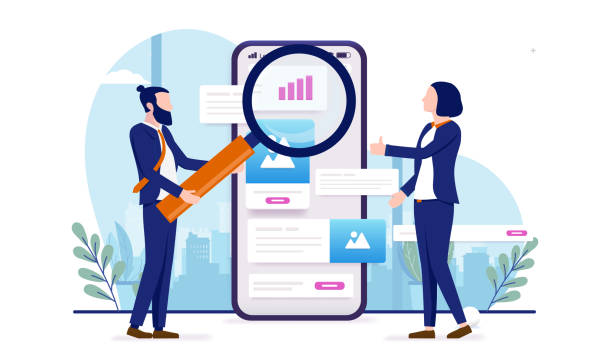Introduction to the Importance of Multilingual Website Design in Today’s World

In the age of #communication and globalization, geographical boundaries have lost their former meaning for businesses.
With the advent of the internet, reaching audiences worldwide has become not only possible but essential.
One of the most important tools for achieving this goal is multilingual website design.
This approach allows websites to present their content in different languages, thereby connecting with a wider range of users across the globe.
The importance of this issue is not limited to large international companies; even small and medium-sized businesses can discover new markets and significantly increase their growth potential by investing in website design.
Today, a significant portion of the global online population does not speak English and prefers to receive information in their native language.
This language preference not only contributes to increased user satisfaction but also leads to higher conversion rates and customer loyalty.
An efficient multilingual website enhances a brand’s credibility and professionalism on an international level, demonstrating that the business values its global audience.
This is a strategic investment for expanding operations and entering emerging markets.
Did you know that 94% of users’ first impressions of a business are related to its website design? Turn this first impression into an opportunity for growth with professional corporate website design by **Rasawweb**.
✅ Attract more customers and increase sales
✅ Build credibility and trust in the eyes of the audience⚡ Get a free website design consultation!
Challenges and Opportunities in Multilingual Website Design

Building a website with the ability to support multiple languages, while offering countless benefits, also presents its unique challenges.
Among the most significant challenges are managing content in different languages, search engine optimization (SEO) in diverse markets, and technical infrastructure maintenance.
The critical question here is how to ensure that translations are not only accurate but also culturally appropriate, conveying the original tone and message correctly? This requires a deep understanding of cultural and linguistic nuances.
Furthermore, coordinating visual design and user experience (UX) in languages with different writing directions (such as Farsi and English, one right-to-left and the other left-to-right) is a major challenge in itself.
However, every challenge also brings an opportunity.
By overcoming these obstacles, businesses can gain unparalleled opportunities for global expansion.
Access to new markets, increased international sales, and strengthened brand credibility on a global scale are just some of these opportunities.
Additionally, multilingual websites can lead to increased traffic through local searches in different countries, thereby significantly expanding the potential customer base.
With careful planning and the use of appropriate tools, these challenges can be turned into great successes.
Technical and Structural Considerations in Implementing Multilingual Website Design

Successful implementation of a multilingual website design project requires a deep understanding of technical and structural considerations.
One of the first important decisions is choosing the appropriate URL structure.
Three main approaches include using country code top-level domains (ccTLDs), subdomains, or subdirectories.
Each of these methods has its own advantages and disadvantages in terms of SEO and management.
For example, ccTLDs (like example.fr) give strong geographical signals to search engines, but their management can be costly and complex.
Subdirectories (example.com/fr/) are often preferred for SEO because they inherit the authority of the main domain and are simpler to manage.
Using hreflang tags is another technical necessity.
These tags help search engines determine the correct version of a page based on the user’s language and geographical region, preventing duplicate content issues.
Correct hreflang implementation is crucial for international SEO.
Furthermore, selecting a content management system (CMS) with strong multilingual capabilities (such as WordPress with WPML or Polylang plugins, or Drupal) is very important.
These CMSs should allow for easy management of translations, publishing content in different languages, and maintaining a multilingual URL structure.
Database design should also support storing and retrieving content in multiple languages.
These specialized aspects provide strong foundations for a successful multilingual website design.
| URL Structure Method | Advantages | Disadvantages | Recommended Use |
|---|---|---|---|
| Country Code Top-Level Domains (ccTLDs) | Very strong geographical signal, complete country separation | High cost, complex management, requires separate domain authority | Very large companies with sufficient budget and resources |
| Subdirectories | Easier management, shares main domain authority, often SEO preferred | Less geographical signal than ccTLDs | Most businesses, especially with a focus on SEO |
| Subdomains | Clear content separation, potential separate hosting | Requires separate domain authority from an SEO perspective (sometimes), more complex management than subdirectories | Very large projects with high structural separation needs |
Content Strategies and Effective Translation for Multilingual Websites

Content is the heart of any website, and in multilingual website design, its effective management and translation are of paramount importance.
Mere word-for-word translation is not enough; one must go beyond that and think about “localization.”
Localization means adapting content to the culture, values, and expectations of the target audience in each region.
This includes aspects such as units of measurement, dates, phone number formats, and even images and colors that may have different meanings in various cultures.
The choice between professional translation and machine translation is also a strategic decision.
While machine translation tools have made significant progress, they still cannot accurately convey linguistic nuances, tone, and cultural concepts.
For sensitive, specialized, or marketing content, investing in native and expert translators is essential.
Creating a glossary of terms and a style guide for each language helps maintain the consistency and quality of translations over time.
Furthermore, content management processes should be designed to allow for easy review and updating of content in all languages.
These comprehensive content approaches ensure that your message reaches global audiences correctly and with the necessary impact.
Are you worried about losing customers because you don’t have a professional e-commerce site?
With e-commerce website design by Rasawweb, forget these worries!
✅ Significant increase in sales and visitor-to-customer conversion rate
✅ Professional and user-friendly design that builds customer trust
⚡ Get a free consultation from Rasawweb
Search Engine Optimization (SEO) for Multilingual Website Design

International SEO is one of the most complex, yet vital, aspects of multilingual website design.
The goal is to ensure that search engines display the correct and relevant version of your website to users in different countries.
In addition to the hreflang tags mentioned earlier, keyword research in each language and geographical region is essential.
Words that have a specific meaning in one language or culture may be different or not used at all in another.
Keyword research tools should be used separately for each target market.
The URL structure, previously explained, also has a direct impact on international SEO.
Google and other search engines use these signals to understand the geographical targeting of pages.
Furthermore, website loading speed and mobile compatibility are important SEO factors for all languages.
Ensuring that servers deliver content quickly to users worldwide (using a CDN) and that the website design performs well on various devices helps improve SEO rankings.
Creating separate XML sitemaps for each language can also contribute to better crawling and correct content indexing.
Ignoring international SEO means losing a large part of the global market potential.
User Experience (UX) and User Interface (UI) in International Website Design

In international website development, attention to user experience (UX) and user interface (UI) for each language and culture is of high importance.
A successful website design must go beyond mere translation and respond to the cultural needs and expectations of users in each region.
The first and most important element is placing a clear and accessible language switcher on every page.
This switcher should be easy to find and allow the user to switch between different languages effortlessly.
Special attention must also be paid to writing direction (such as right-to-left for Farsi and Arabic, and left-to-right for English and many other languages).
This affects the overall page layout, text alignment, and the placement of UI elements like buttons and forms.
Colors and images must also be chosen carefully; a color may have a positive meaning in one culture and a negative one in another.
Fonts must be capable of correctly displaying characters for all supported languages.
Additionally, input forms should be ready to accept data in various formats (such as phone numbers and postal codes).
User research in each target market can provide valuable insights for optimizing UX and UI.
Useful Tools and Platforms in Multilingual Website Design

To facilitate the process of building a multilingual website, various tools and platforms are available, each with its own features and capabilities.
The choice of the right tool depends on the CMS type, budget, and project complexity.
On platforms like WordPress, plugins such as WPML and Polylang are highly popular.
WPML is a comprehensive and powerful plugin that allows for easy management of translations for posts, pages, categories, tags, and even themes and plugins.
Polylang is a lighter and free option that effectively covers the basic needs of making a site multilingual.
For larger and enterprise projects, Translation Management Systems (TMS) like Smartling, Phrase, and MemoQ can significantly streamline and automate the translation and localization process.
These systems allow translation teams to work concurrently on projects and use Translation Memory (TM) and Terminology Glossary (TG) tools to maintain consistency.
Additionally, using Content Delivery Networks (CDN) like Cloudflare or Akamai to increase website loading speed worldwide is essential for a multilingual website design aiming for optimal performance.
These tools improve user experience by reducing server response time and aid in international SEO.
| Tool/Platform Name | Type | Main Use | Key Advantages |
|---|---|---|---|
| WPML | WordPress Plugin | Multilingual content management in WordPress | Comprehensive, strong support, SEO capabilities |
| Polylang | WordPress Plugin | Making WordPress multilingual | Free, lightweight, simple user interface |
| Smartling | Translation Management System (TMS) | Automation and management of the translation process | High scalability, TM and TG tools, CMS integration |
| Cloudflare | Content Delivery Network (CDN) | Increased website speed and security | Reduced loading time, protection against DDoS attacks |
Ongoing Maintenance and Updates for Multilingual Websites

Launching a multilingual website is just the beginning; its ongoing maintenance and updates are equally important for preserving its efficiency and effectiveness.
Website content, both textual and visual, must be regularly reviewed and updated in all languages to ensure information is always accurate and relevant.
This includes updating product information, services, company news, and blog articles.
Any changes in one language should be promptly extended to other languages as well.
Monitoring website performance in each target market is also crucial.
This involves tracking traffic, conversion rates, and user feedback in each language.
Technical or translation issues must be identified and resolved quickly to prevent a negative user experience.
Website security should also be seriously considered across all language versions.
Security updates for the CMS, plugins, and themes must be performed in a timely manner.
Finally, planning for the scalability of the website to add new languages in the future is a smart and long-term perspective.
Active maintenance ensures the sustainable success of a multilingual website design in the long run.
Are you frustrated with your e-commerce site’s low conversion rate? Rasawweb transforms your e-commerce site into a powerful tool for attracting and converting customers!
✅ Significant increase in visitor-to-buyer conversion rate
✅ Exceptional user experience to boost customer satisfaction and loyalty⚡ Get a free consultation from Rasawweb!
Case Studies and Business Successes with Multilingual Website Design

Numerous pieces of evidence demonstrate significant business successes after implementing multilingual website design, further highlighting the importance of this approach.
For example, large technology companies like Apple or Microsoft offer their websites in dozens of languages to access global markets.
This enables them to effectively introduce their products to customers worldwide and provide customer support in the local language.
The result of these efforts is increased customer loyalty and global market share.
Even smaller companies can achieve success with this approach.
For instance, a small business producing handicrafts in Iran can offer its products to European and Middle Eastern markets by creating a website in English, Arabic, and German.
This action not only leads to increased sales but also helps with brand recognition at an international level.
These examples show how investing in multilingual website development can open doors to new opportunities and help companies transcend geographical limitations to achieve their global goals.
The Future of Smart and Advanced Multilingual Website Design

The future of multilingual website design is moving towards intelligence and technological advancements that will further automate and personalize the localization process.
One of the most important developments is the wider use of Artificial Intelligence (AI) and Machine Learning (ML) in translation and localization.
While current machine translation still requires human editing, future generations of AI can provide higher quality and more culturally accurate translations, which not only reduces time and cost but also better understands linguistic nuances.
Additionally, content personalization based on user profiles, geographical location, and even browsing history, allows multilingual websites to offer a much more targeted experience.
For example, a website can automatically suggest specific content based on the user’s cultural preferences.
The development of voice search in different languages and optimizing websites to respond to these types of searches are also future trends.
Future multilingual websites will not only provide information in multiple languages but will also interact with users dynamically and intelligently to provide the best possible experience.
These advancements open new horizons for multilingual website design.
Frequently Asked Questions
| Question | Answer |
|---|---|
| What is a multilingual website? | A website whose content is available to users in more than one language. |
| Why should I make my site multilingual? | To access a wider audience in global markets, improve user experience, and enhance international SEO. |
| What are the technical approaches for building a multilingual site? | Using subdirectories, subdomains, or URL parameters to differentiate languages. |
| How does multilingual design affect SEO? | By targeting local keywords and providing content in users’ native languages, the site’s ranking in search engines for those regions improves. |
| What are the challenges of multilingual website design? | Managing content translation, supporting Right-to-Left (RTL) direction, technical issues related to language addressing, and maintaining design consistency. |
| How do we choose the languages for a multilingual site? | Based on target audience analysis, desired markets, and current site traffic data (if available). |
| What is RTL support and why is it important for some languages? | Right-to-Left refers to the display direction of text and page elements from right to left, which is essential for languages like Farsi, Arabic, and Hebrew. |
| How do we manage multilingual site content? | Using content management systems (CMS) with multilingual capabilities, translation plugins, or professional translation services. |
| How is user experience (UX) in a multilingual site? | The ability to easily change languages should be provided, and translated content should be of high quality so that users feel comfortable. |
| What are common CMS platforms for multilingual sites? | WordPress (with plugins like WPML), Joomla, Drupal, and Shopify (with relevant settings or plugins). |
And other services of Rasaweb Advertising Agency in the field of advertising
Smart Marketing Automation: A dedicated service for online growth based on custom programming.
Smart Link Building: A new service to enhance customer behavior analysis through precise audience targeting.
Smart Content Strategy: A new service to increase website visits through intelligent data analysis.
Smart Link Building: A combination of creativity and technology for campaign management through precise audience targeting.
Smart Marketplace: A fast and efficient solution for customer acquisition with a focus on attractive user interface design.
And over hundreds of other services in the field of internet advertising, advertising consultation, and organizational solutions
Internet Advertising | Advertising Strategy | Advertorial
Resources
Multilingual Website Design Training with WordPress
Multilingual Website Design
Important Tips for Multilingual Website Design for Global Success
What are the advantages of multilingual website design?
✔️ Are you looking for your business to grow and be seen in the digital world? Rasaweb Afarin Digital Marketing Agency, relying on up-to-date knowledge and extensive experience in user-friendly website design and implementing effective online marketing strategies, is always ready to assist you in achieving great successes.
📍 Tehran, Mirdamad Street, next to Bank Markazi, Southern Kazeroun Alley, Ramin Alley, Plaque 6

